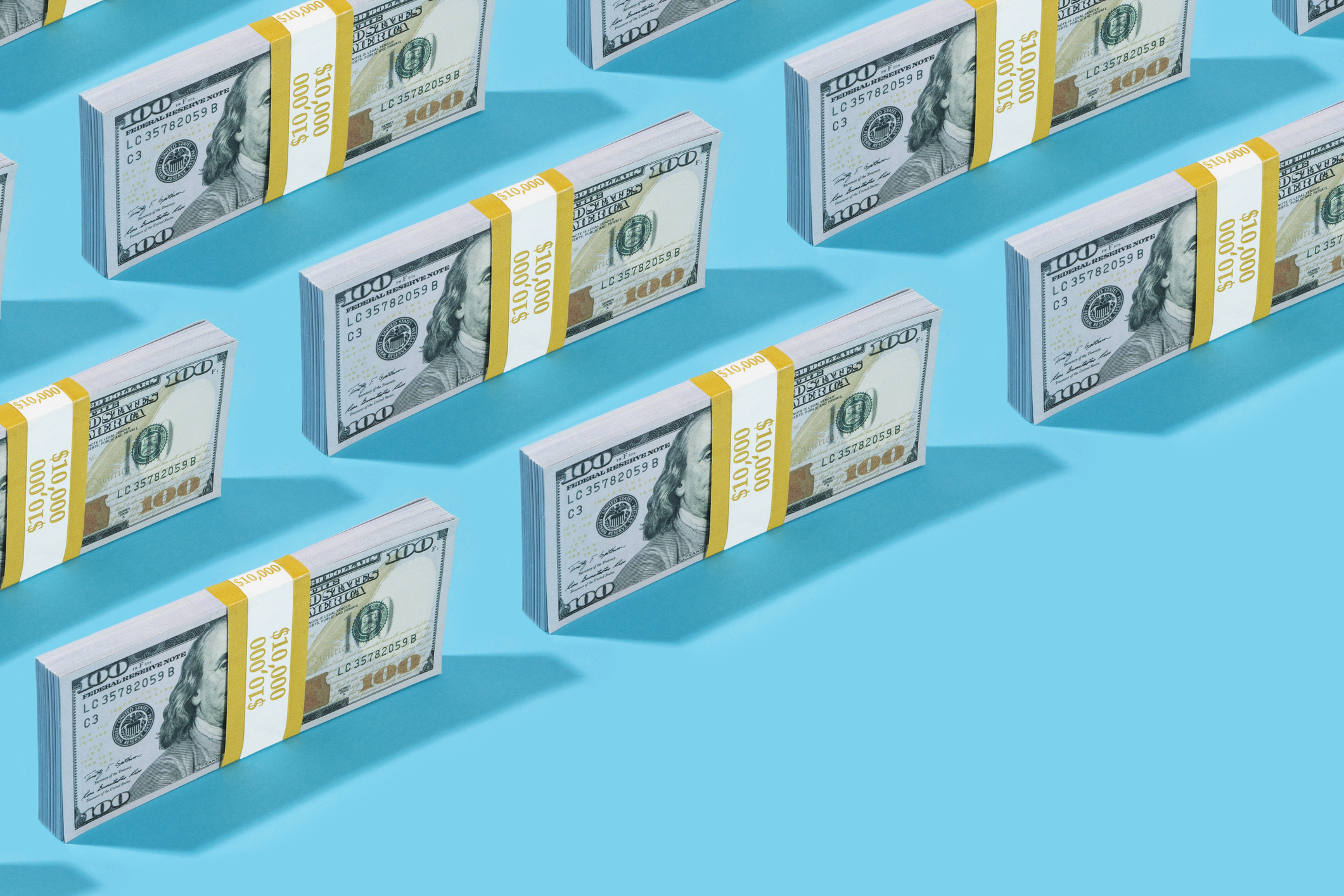Are High-Yield Savings Accounts Still Outpacing Inflation?
Some savings accounts give you the ability to outpace inflation, lessening its impact on your finances.


Inflation continues to take significant bites out of household budgets. July inflation sits at 2.7%, the same as June's.
Food prices remain expensive, as beef prices have hit an all-time high, per Newsweek. Cumulative inflation shows the real impact consumers continue to face. Bankrate found prices are more than 24% higher than they were in February 2020.
If you're feeling inflation's squeeze on your finances, you're far from alone. Thankfully, there are ways of cushioning your finances against inflation, and one of the best ways to achieve this is by placing your money in high-yield savings accounts.
From just $107.88 $24.99 for Kiplinger Personal Finance
Become a smarter, better informed investor. Subscribe from just $107.88 $24.99, plus get up to 4 Special Issues

Sign up for Kiplinger’s Free Newsletters
Profit and prosper with the best of expert advice on investing, taxes, retirement, personal finance and more - straight to your e-mail.
Profit and prosper with the best of expert advice - straight to your e-mail.
Do savings accounts really outpace inflation?
If you open a savings account at a brick-and-mortar bank, chances are you're going to be disappointed. Traditional savings accounts offer a 0.6% APY on average, making it far below inflation's 2.7% rate.
However, a high-yield savings account offers much healthier returns. Some of our top options, such as this one from Newtek Bank, give you a return of 4.35%, well above the inflation rate.
Newtek Bank high-yield savings account
This account earns you 4.35% APY with no account minimums, allowing you to outpace inflation easily.
Another perk is that many high-yield savings accounts come with low deposit requirements and no monthly fees. This helps you keep more of your money, which is integral given inflation's impact.
How much can I earn with a high-yield savings account?
Let's take our top pick Newtek Bank, that earns 4.35% APY. Here's how much you would earn in one year for opening the account today:
- $10,000 deposit: $435 in interest
- $25,000 deposit: $1,087.50 in interest
- $50,000 deposit: $2,175 in interest
- $100,000 deposit: $4,350 in interest
As you can see, this approach could help you earn significant gains effortlessly. This calculation assumes there will be no rate cuts in the next year from the Federal Reserve.
While that's unlikely, given the weak job numbers, inflation could prompt the Fed to continue its wait-and-see approach. This is important because high-yield savings accounts come with variable interest rates, meaning that if the Fed cuts rates, it will also drop your rate of return.
What savings alternatives should I consider?

If you're worried about rate cuts eating into earnings, another approach is to open a certificate of deposit. Unlike HYSAs, CDs feature fixed interest rates.
It means if you lock in your rate now and the Fed cuts them later this month, it won't impact you since you have your rate locked in.
You can shop quickly for the best CD rates, using this tool, powered by Bankrate:
There are a few things to keep in mind with a CD. First, many come with terms that won't allow you to withdraw your money until it reaches its maturity date. If you need cash before that time, your penalties could be months of earned interest, negating its benefit.
You can’t add to your balance the way you would with a high-yield savings account, so CDs are best suited for a lump sum you won’t need for awhile — letting you lock it into a risk-free vehicle that outpaces inflation.
Another option is a money market account. These are better-suited for established savers, as many accounts require a minimum balance of $1,000. In many ways, these accounts offer the best perks of checking, in that you can access your money anytime you want with a debit card.
Moreover, you'll gain all the perks of a savings account, including returns as high as 4.35%. This will also allow you to earn more money than inflation takes. However, as with a high-yield savings account, money market accounts come with variable interest rates. If the Fed cuts rates sometime soon, it could lower your returns.
If you're on the fence about savings options, this table can help:
Savings vehicle | Cash access | Minimum balance requirement? | Best for? |
|---|---|---|---|
High-yield savings account | Anytime you need it | Most online accounts don't have balance requirements | Savers looking to build an emergency fund or have cash access |
CDs | When your term ends, outside of no-penalty CDs | At least $500 | Established savers looking to shield money from rate cuts/inflation |
Money market accounts | Anytime you need it, though there might be restrictions on how often you can access it | At least $1,000 | Established savers looking for quick cash access |
Overall, there are several ways you can save money and stay ahead of inflation. High-yield savings accounts are the easiest, as they come with the fewest restrictions and only take a few minutes to set up.
Best of all, with rates as high as 4.35%, you'll earn a rate outpacing inflation, even if the Fed cuts rates and savings APYs drop. Therefore, if you're feeling inflation's squeeze, the right savings accounts can lessen its impact.
Related content
Profit and prosper with the best of Kiplinger's advice on investing, taxes, retirement, personal finance and much more. Delivered daily. Enter your email in the box and click Sign Me Up.

Sean is a veteran personal finance writer, with over 10 years of experience. He's written finance guides on insurance, savings, travel and more for CNET, Bankrate and GOBankingRates.
-
 I'm want to give my 3 grandkids $5K each for Christmas.
I'm want to give my 3 grandkids $5K each for Christmas.You're comfortably retired and want to give your grandkids a big Christmas check, but their parents are worried they might spend it all. We ask the pros for help.
-
 If You're Not Doing Roth Conversions, You Need to Read This
If You're Not Doing Roth Conversions, You Need to Read ThisRoth conversions and other Roth strategies can be complex, but don't dismiss these tax planning tools outright. They could really work for you and your heirs.
-
 Could Traditional Retirement Expectations Be Killing Us?
Could Traditional Retirement Expectations Be Killing Us?A retirement psychologist makes the case: A fulfilling retirement begins with a blueprint for living, rather than simply the accumulation of a large nest egg.
-
 My Teen Crashed His Car and Now Our Insurance Has Tripled. What Now?
My Teen Crashed His Car and Now Our Insurance Has Tripled. What Now?Dealing with the costly aftermath of a teen car accident is stressful. Here are your options for navigating it.
-
 My First $1 Million: Retired In-House Corporate Lawyer, 74, Midwest
My First $1 Million: Retired In-House Corporate Lawyer, 74, MidwestEver wonder how someone who's made a million dollars or more did it? Kiplinger's My First $1 Million series uncovers the answers.
-
 I'm an Insurance Pro: Going Without Life Insurance Is Like Driving Without a Seat Belt Because You Don't Plan to Crash
I'm an Insurance Pro: Going Without Life Insurance Is Like Driving Without a Seat Belt Because You Don't Plan to CrashLife insurance is that boring-but-crucial thing you really need to get now so that your family doesn't have to launch a GoFundMe when you're gone.
-
 The Top 22 Gifts for Grandkids from Walmart in 2025
The Top 22 Gifts for Grandkids from Walmart in 2025From PlayStation to Labubu, you'll find the hottest gifts of 2025 for your grandkids at Walmart this year. Some of them are up to 78% off.
-
 CD vs. Money Market: Where to Put Your Year-End Bonus Now
CD vs. Money Market: Where to Put Your Year-End Bonus NowFalling interest rates have savers wondering where to park cash. Here's how much $10,000 earns in today's best CDs versus leading money market accounts.
-
 Meet the World's Unluckiest — Not to Mention Entitled — Porch Pirate
Meet the World's Unluckiest — Not to Mention Entitled — Porch PirateThis teen swiped a booby-trapped package that showered him with glitter, and then he hurt his wrist while fleeing. This is why no lawyer will represent him.
-
 Smart Business: How Community Engagement Can Help Fuel Growth
Smart Business: How Community Engagement Can Help Fuel GrowthAs a financial professional, you can strengthen your brand while making a difference in your community. See how these pros turned community spirit into growth.
-
 Smart Money Moves Savers Should Make in 2026
Smart Money Moves Savers Should Make in 2026These steps will get you on the road to achieving your 2026 savings goals.
